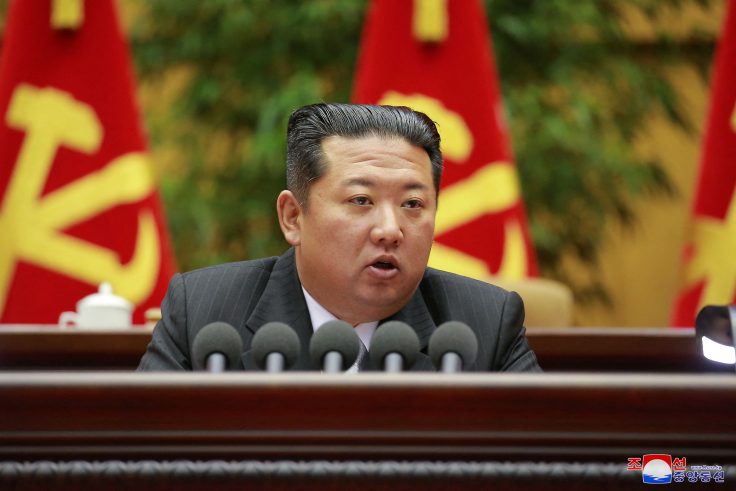By Josh Smith and Hyonhee Shin
SEOUL (Reuters)—North Korea conducted what is thought to be its largest intercontinental ballistic missile (ICBM) test ever on Thursday, the South Korean and Japanese militaries said, marking a dramatic end to a self-imposed moratorium on long-range testing.
It would be the first full-capability launch of the nuclear-armed state's largest missiles since 2017, and represents a major step in the North's development of weapons that might be able to deliver nuclear warheads anywhere in the United States.
The North's return to major weapons tests also poses a new national security headache for U.S. President Joe Biden as he responds to Russia's invasion of Ukraine, and presents a challenge to South Korea's incoming conservative administration.
"This launch is a brazen violation of multiple U.N. Security Council resolutions and needlessly raises tensions and risks destabilizing the security situation in the region," White House press secretary Jen Psaki said in a statement condemning the launch.
"The door has not closed on diplomacy, but Pyongyang must immediately cease its destabilising actions."
North Korea had put its ICBM and nuclear tests on hold since 2017, but has defended the weapons as necessary for self-defence, and said U.S. diplomatic overtures are insincere as long as Washington and its allies maintain "hostile policies" such as sanctions and military drills.
South Korea's outgoing President Moon Jae-in, who made engaging North Korea a major goal of his administration, condemned the launch as "a breach of the moratorium on ICBM launches that Chairman Kim Jong Un himself promised to the international community".
It was also a serious threat to the Korean peninsula, the region and the international community, and a clear violation of U.N. Security Council resolutions, added Moon, who is due to leave office in May.
The latest missile launch was an "unacceptable act of violence", Japanese Prime Minster Fumio Kishida said.
Thursday's ICBM launch prompted South Korea to test-fire a volley of its own, smaller ballistic and air-to-ground missiles to demonstrate it has the "capability and readiness" to precisely strike missile launch sites, command and support facilities, and other targets in North Korea if necessary, South Korea's Joint Chiefs of Staff said in a statement.
U.S. Secretary of State Antony Blinken spoke by phone with counterparts in Japan and South Korea after the launch. Japanese Foreign Minister Yoshimasa Hayashi said they had agreed that North Korea's move represented a clear and grave challenge to the international community.
Blinken and South Korean Foreign Minister Chung Eui-yong called for a decisive response and agreed that additional measures by the U.N. Security Council were essential, South Korea's foreign ministry said in a statement.
NEW ICBM?
Thursday's launch would be at least the 11th North Korean missile test this year, an unprecedented frequency.
Japanese authorities said the launch appeared to be a "new type" of ICBM that flew for about 71 minutes to an altitude of about 6,000km (3,728 miles) and a range of 1,100 km (684 miles) from its launch site.
It landed inside Japan's exclusive economic zone (EEZ), 170 km (106 miles) west of the northern prefecture of Aomori, at 3:44 p.m. (0644 GMT), the coast guard said.
South Korea's Joint Chiefs of Staff put the missile's maximum altitude at 6,200 km and its range at 1,080 km.
That is further and longer than North Korea's last ICBM test in 2017, when it launched a Hwasong-15 missile that flew for 53 minutes to an altitude of about 4,475 km and range of 950 km.
South Korea's JCS said the latest missile was launched from near Sunan, where Pyongyang's international airport is located. On March 16, North Korea launched a suspected missile from that airport that appeared to explode shortly after liftoff, South Korea's military said.
U.S. and South Korean officials have warned recently that North Korea had been preparing to test-fire its largest ICBM yet, the Hwasong-17.
U.S. officials said at least two recent tests, on Feb. 27 and March 5, featured the Hwasong-17 system, but did not demonstrate full ICBM range or capability.
Pyongyang did not identify the missile system used in those launches, but said they were testing components for a reconnaissance satellite system.
This month, leader Kim said North Korea would soon launch multiple satellites to monitor military movements by the United States and its allies.
Analysts say the Hwasong-17 is "considerably larger" than the Hwasong-15, and would be one of the world's largest road-mobile ICBMs. It was first unveiled in October 2020 and displayed a second time in October 2021.
'SERIOUS PROGRESS'
Amid a flurry of diplomacy in 2018, Kim declared a self-imposed moratorium on testing ICBMs and nuclear weapons, but later suggested the North could resume such testing amid stalled denuclearization talks.
That moratorium had often been touted as a success by former U.S. President Donald Trump, who held historic summits with Kim in 2018 and 2019, but never gained a concrete pact to limit the North's nuclear or missile arsenals.
New construction has also been spotted at North Korea's only known nuclear test site, which was shuttered in 2018.
The looming prospect of possible nuclear tests, more joint U.S.-South Korea military drills, and the new conservative South Korean president mean "all conditions are present for a tit-for-tat chain reaction of escalatory steps", said Chad O'Carroll, CEO of Korea Risk Group, which monitors North Korea.
"Though Biden would prefer to focus exclusively on the Ukraine crisis, it's likely he will soon face crisis-level tensions between the Koreas," he said.
With the sanctions regime at an impasse at the U.N. Security Council and North Korea opposed to talks on denuclearization for the foreseeable future, Pyongyang is now likely capable of making serious progress on its weapons development program with little risk of substantive punishment, O'Carroll added.
(Reporting by Josh Smith, Hyonhee Shin, and Ju-min Park in Seoul, and Sakura Murakami in Tokyo; Editing by Gerry Doyle, Clarence Fernandez and Nick Macfie)
